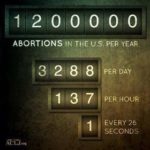 “Excellent rebuttal to the pro-abortion “unanswerable argument”. Having said that , the pro-life twitter responses are mostly pathetic and do not address the challenge. This article stays with the question and does so logically. Ben Shapiro does so too in a more popular fashion on You Tube. Read the article and learn how to answer this pseudo intellectual & his minions. Defend life.” – Joe Godal
“Excellent rebuttal to the pro-abortion “unanswerable argument”. Having said that , the pro-life twitter responses are mostly pathetic and do not address the challenge. This article stays with the question and does so logically. Ben Shapiro does so too in a more popular fashion on You Tube. Read the article and learn how to answer this pseudo intellectual & his minions. Defend life.” – Joe Godal
Article by Robert P. George and Christopher O. Tollefsen (original source here)
Robert P. George is McCormick Professor of Jurisprudence at Princeton University, and Christopher O. Tollefsen is College of Arts and Sciences Distinguished Professor of Philosophy at the University of South Carolina. They are co-authors of Embryo: A Defense of Human Life, from which this essay is adapted.
Both human embryos and human five-year-olds are human beings equal in fundamental worth and dignity. But there are differences between the embryos and five-year-olds that are or can be morally relevant to the decision concerning whom to rescue.
Errors and bad arguments abound on Twitter; it is simply impossible to respond to all of them.
Yet when the errors and bad arguments concern the value of unborn human lives, and when those errors and arguments have, apparently, been so rhetorically persuasive as to generate many thousands of retweets, then perhaps they should be addressed.
This seems to be the case with a recent series of tweets by Patrick L. Tomlinson, who writes, “Whenever abortion comes up, I have a question I’ve been asking for ten years now of the ‘Life begins at Conception’ crowd. In ten years, no one has EVER answered it honestly.” He then offers a scenario, proposed earlier by Michael Sandel at a meeting of the President’s Council on Bioethics, and even earlier by George Annas. Sandel asks us to imagine that a building is on fire and Jones, who is trying to escape, can save ten frozen embryos or one five-year-old girl, but not both (Mr. Tomlinson’s example substitutes 1,000 frozen embryos, on which more later).
Now, by saving a crate of embryos, Jones would, on the “Life Begins at Conception” account, be saving many human beings (virtually every embryologist or developmental biologist would agree; this is easily verified by a look at the relevant textbooks). Yet it seems plausible that most reasonable people, among whom we will include Jones, would save the five-year-old girl. Can we agree that this choice is reasonable, given our view not just of the nature of the frozen embryos—they are human beings—but also of their value, for we hold that they are beings equal in fundamental worth and dignity to those other human beings currently reading this essay? Does our willingness to accept Jones’s choice as morally legitimate show that, in truth, we do not regard human embryos as we regard children at later stages of development, namely, as full members of the human family?
We agree that considering the case as described by Sandel, most people in Jones’s circumstances would choose to rescue the girl. However, this by no means shows that human embryos are not human beings or that they may be deliberately killed to produce stem cells, or in an abortion.
The first thing to notice is that the case as described is not, in fact, analogous to the suggestion that we should perform embryo-destructive research for the benefits it might provide us, or to the suggestion that it is permissible to abort an unborn human being. In both such cases, we are being invited to kill, or authorize the killing of, human embryos or fetuses in order to provide benefits to others. But in the fire scenario, there is no killing; the deaths of the embryos who are lost when Jones opts to save the girl are not killings—no one is acting to destroy the embryos or cause their deaths—but rather are the kind of death we accept as side effects in various cases in which, for example, acting to save one or some persons means that we are unable to save another or others. Continue reading →


